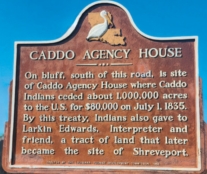What’s in a Name?

This region owes much to the Caddo people
The word “Caddo” is ubiquitous in Northwest Louisiana. It is a name that is prevalent in our everyday lives, yet we rarely consider it. We ascribe the words to everything from our parish to schools, radio stations, parks, businesses and even a lake. But why?
To answer this, we must first ask the question: Who were the Caddo people?
The Caddo people were a large, culturally diverse collection of indigenous tribes who called Northwest Louisiana and the surrounding region home long before the arrival of Europeans to North America. According to the National Park Service, the name Caddo is an abbreviation of the word “Kadohadacho,” which means “real chief.”
Originally from the Mississippi Valley, the Caddo people settled in present-day Oklahoma, Texas, Louisiana and Arkansas around the 9th century. They remained in the region until the early 19th century. The Caddo people called the Ark-La-Tex home for roughly 1,000 years. (To put that in historical perspective, the United States is a mere 247 years old.)
With a dynamic, complex culture that lasted for centuries, the Caddo people left behind an incredible history of art, trade and agriculture that is quite literally underneath our feet. Numerous Caddo archaeological sites dot the region; from those, archaeologists and researchers have pieced together a remarkable picture of the Caddo culture.
Largely agrarian, the Caddo people farmed the fertile river valleys of the Ark-La-Tex, including the Sabine, Sulphur, Neches, Ouachita and Red rivers. They grew corn, maize, beans and squash, among other crops. In addition to farming, they were hunters, artists, traders and builders. The Caddo were known, too, for their earthen mounds. In Caddoan culture, the mounds were places of cultural and spiritual significance. At the height of their strength – around the year 1300 – it is estimated the Caddo people may have numbered more than 200,000.
As with all indigenous North American tribes, the fate of the Caddo people changed with the arrival of European explorers.
The Spanish and French were the first to encounter Caddo tribes. Later, as the Anglo-American population grew, the Caddo tribes were forced to deal with endless encroachment on their homelands.
By the early 1800s, it had become increasingly difficult for the Caddo people to maintain their way of life. On July 1, 1835, “Chiefs, head men, and Warriors of the Caddo nation of Indians” met with Jehiel Brooks, commissioner on the part of the United States, and formally signed away more than one million acres of land to the United States for $80,000.
Article III of the treaty read:
In consideration of the aforesaid cession relinquishment and removal it is agreed that the said United States shall pay to the said nation of Caddo Indians the sums in goods, horses and money hereinafter mentioned, to wit—
Thirty thousand dollars to be paid in goods, and horses, as agreed upon to be delivered on the signing of this treaty.
Ten thousand dollars in money to be paid within one year from the first day of September next.
Ten
thousand dollars, per annum in money for the four years next following
so as to make the whole sum paid and payable eighty thousand dollars.
The signing of the document brought an ignominious end to the ancestral Caddo homelands as they had been known for a millennium. The ceremony took place at the Caddo Agency House located in present-day south Shreveport. A historical marker near the intersection of Ellerbe Road and Flournoy-Lucas Road commemorates the event.
The
fractured Caddo people would never be the same. After dispersing to
Texas and Mexico, remnants of the Caddo people eventually settled in
Oklahoma. Today, the Caddo Nation is formally headquartered in Binger,
Okla. Fittingly, Binger is in Caddo County.
Evidence of the Caddo people and their lasting influence on the region is easy to find. One such location is the Caddo Mounds State Historic Site in Alto, Texas – a two-hour drive from Shreveport. Visitors can learn about the everyday life and history of the Caddo people while exploring three well-preserved Caddoan mounds. (On Sept.2, Caddo Mound State Historic Site will host a Caddo Culture Day.)
Visitors can also see mounds at Spiro Mounds Archaeological Center in Spiro, Okla. Spiro Mounds is the only prehistoric American Indian archaeological site in Oklahoma open to the public.
Closer to home in Louisiana, Caddo mounds still exist but are mostly on private property. According to archaeological research, there are as many as 40 Caddoan sites between Natchitoches, La., and the Arkansas state line. Among them are the Gahagan Site, the Belcher Mound Site and the Mounds Plantation near Dixie.
In June of 2017, Hosston residents Robert Cornett and Jeanna Bradley discovered a wooden 34-foot canoe on the banks of the Red River that was believed to be carved by the Caddo people. Astonishingly, the wellpreserved canoe was estimated to be 900 years old.
Years earlier, in 1983, a similar discovery was made in the same area. That canoe is currently displayed in the “Gallery of the Caddo Nation” at the Louisiana State Exhibit Museum in Shreveport.
As evidenced by the prevalence of historical artifacts, art and, of course, the word “Caddo” in our community – the legacy of the Caddo people lives on in the Ark-La- Tex. Today, the Caddo Nation still regards the Ark-La-Tex as the ancestral homeland of the Caddo people.
Today, the Caddo Nation remains a thriving community that continues to honor its storied past. According to their web site, the Caddo Nation “actively preserves and promotes their heritage through cultural programs, language revitalization initiatives and art exhibitions.” And noting their incomprehensibly long history as a people, they also poetically state, “We are an ancient tribe. We have been here since time immemorial. And we will continue to be here.”
